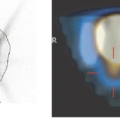Introduction
This part of the book deals mainly with PET-CT and SPECT-CT imaging of tumors for staging and therapy control. Thus, with regard to PET, it is especially concerned with FDG imaging of tumors, which is the most important clinical application of PET. Imaging of tumors is essentially imaging of “hot spots,” and the key to success with FDG-PET imaging, as well as some SPECT tumor imaging applications, is that the lesions are conspicuous, stand out in an image, and therefore are frequently well demonstrated (see Fig. 33.2). There are different ways of analyzing a PET scan. In FDG-PET, one way is simply to note the lesions and describe them. The problem with this approach is that lesions vary widely in activity, and the strength of uptake is an indication of the nature of a lesion. For example, relatively weak focal bilateral uptake in the hilar regions of the lung of a patient is likely due to chronic bronchitis, whereas strong uptake suggests hilar nodal involvement by bronchial carcinoma.
Therefore, many PET experts measure the standardized uptake value (SUV) of lesions, as this is a quantitative measure (1). Much literature defines SUV thresholds above which a lesion for a given tumor type is pathological, but unfortunately the discriminatory value of these thresholds is limited. A practical approach is to “window” and “level” body PET scans in a consistent fashion. In this approach, the brain FDG uptake is used as a reference, and the image gray scale is set such that the cortex of the brain is just at that level and black. Since FDG uptake into the brain is pretty constant unless the patient is a diabetic,
this level setting gives an upper reference point for the image gray scale. The lower end is set to zero. Using this approach, lesions can consistently be classified as having very high uptake (comparable to the brain cortex) (grade 4), high uptake (grade 3), moderate uptake (grade 2), and weak uptake (grade 1). Many images shown in Parts V and VI of this book are windowed in this way. Although this approach is excellent for the initial staging of tumors, it may not be adequate when subtler changes in FDG uptake are to be analyzed to evaluate the effects of a therapeutic regimen. Then, SUVs have to be used.
this level setting gives an upper reference point for the image gray scale. The lower end is set to zero. Using this approach, lesions can consistently be classified as having very high uptake (comparable to the brain cortex) (grade 4), high uptake (grade 3), moderate uptake (grade 2), and weak uptake (grade 1). Many images shown in Parts V and VI of this book are windowed in this way. Although this approach is excellent for the initial staging of tumors, it may not be adequate when subtler changes in FDG uptake are to be analyzed to evaluate the effects of a therapeutic regimen. Then, SUVs have to be used.
Stay updated, free articles. Join our Telegram channel

Full access? Get Clinical Tree







